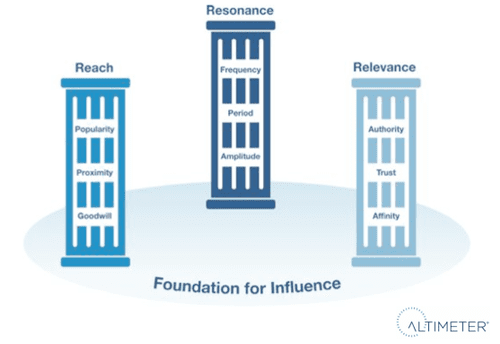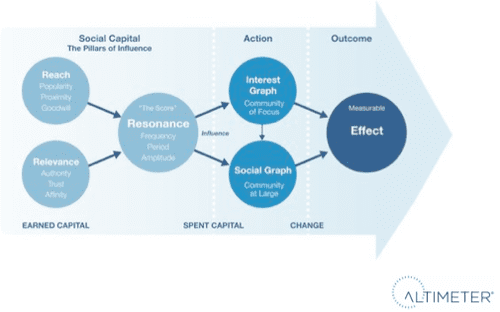What is the true meaning of online influence?
We hear a lot about influence now, it’s a commonplace term when we’re talking about social media marketing. With so many tools available to help us understand what that means and what to do - tools such as Klout, Kred, PeerIndex, and Radian6 – what does influence really mean to us, as individuals and brands? And, what about all of those tools that claim to be able to help us leverage it?
The new report
Brian Solis (now Altimeter Group’s principal analyst) has released a free report to help us understand the tools available, what they do and how we might best make used of them when marketing to influential people. He’s done this through interviews and software demos with vendors, detailed reviews of 17 services providers, a review of 6 brands that have publicly piloted digital influence programs and a final quantitative study of vendor features against key criteria for influence engagement. Serious stuff!
You can see the report here and I've added my summary of what I took from it below.
First: The pillars of influence
Solis explains why he thinks that influence is largely misunderstood, and defines what he believews influence actually is:
“Digital Influence: The ability to cause effect, change behaviour, and drive measurable outcomes online.”
He suggests that, initially at least, you should forget the software tools, they don’t define what the pillars are and are only helpful in supporting your goals and the outcome. Measuring influence is a means to an end and not the end in itself.
Solis has helped break down influence into three simple pillars, shown in this review too:

- Pillar 1 — Reach: Relationships form the union of the social graph and define how far information can travel across the social graph and communities at large. Reach is a measure of popularity, affinity, and potential impact.
- Pillar 2 — Relevance: Topical relevance is the glue of the interest graph and the communities of focus. Individuals aligned through subject matter create a series of linked relationships that send information along communities of focus.
- Pillar 3 — Resonance: The culmination of reach and relevance serve as the foundation for “the score.” Here, resonance is the measurement of the duration, rate, and level of interactivity around content, a topic, or conversations. High resonance ensures that more people will see each post or update. In theory, this number determines the reach of activity and how long it can stay alive in the social streams of online consumers.
Social capital is the key
Solis says that social capital is the catalyst for influence. This part of the report struck me the most.
“ The idea that only large networks can cause effect is a myth… Now, you can connect with people based on common interests through the influential voices who are frequently the hub of important conversations. As they share information, you can track the ripples from person to person… Defining upfront what it is you want to cause will then allow you to test the combination of people, information, and campaigns to help you achieve your goals”.
David Armano, Snr VP at Edelman Digital
Solis says that “a person’s stature within each network can directly affect behaviour or cause an effect” and that “the Pillars of Reach and Relevance offer a series of levers that, when aligned with a creative strategy, can create favourable conditions for cause and effect.” I wrote recently on the point regarding creative campaigns too, so interesting to see that word here.
It is in fact pretty obvious (the best insight tends to be!), he’s saying that influence is about the quality of the connections that influencers have, not just the quantity – so it’s what you do with it that counts! How many times have you used that "quality" expression with email list size or web traffic – well, it’s the same thing here. It boils down to the social currency of individuals being more critical than network size.

Building your measurement framework
The advice here is to direct this thinking to work for you and your brand by first building your own measurement framework depending on your objectives. The top-level metrics in the report to help spark ideas are:
- Brand Lift/Awareness — Benchmark where the company is today in social networks, and set goals and KPIs to improve brand awareness and reach.
- Brand Resonance — How often is your business discussed in the social web today? Define how resonance will keep your business top of mind and to what extent can be driven through influence programs.
- Reach Through Advocacy and WOM — Existing advocacy and WOM initiatives can be designed to influence customer behaviour and decisions.
- Sales/Referrals — Through special offers and promotions or exclusive incentives for engagement, brands can drive leads, sales, and referrals.
- Sentiment/Shift — Negative or indifferent perception can be shaped toward positive or favourable views.
- Thought Leadership/Authority — Tapping into the communities of expert individuals can help your brand tap its social capital to contribute to the stature within the community you hope to earn.
- Demand — Invest in demand creation through exclusive programs and intentional outcomes.
- Trends — Changing behaviour is possible once you understand what it is today, how you see it evolving, and identifying the right people and value to help you get there.
- Audience — Investing in the size of your community and its quality is a function of design and purpose, and its value grows through strategic alignment and engagement.
Essentially, when developing an influencer campaign, you’ll need to match which elements align to the objective. If brand awareness is the objective, recruiting individuals who are popular will matter. If the objective is to establish thought leadership, then individuals who possess authority or trustworthiness become much more important.
Next, develop your action plan
- Benchmark: Understand where you are today to track performance against current benchmarks.
- Audience: Define who you’re ultimately trying to reach, where they get information, who they’re connected to, and what it is they value.
- Strategy: Develop a strategy that connects the dots between you, connected consumers, and their communities.
- Influencer ID: These individuals form the strategic alliances necessary to achieve your goals.
- Campaign: The campaigns that you execute must be enhanced in real time. Rarely do any digital influence programs perform as designed.
- Measurement: Integrate milestones and mechanisms to measure KPIs and also outcomes.

Software to help you execute
Of course, this whole process requires the right software, and there’s lots of it to choose from. The appendix in the report is hefty with clearly benchmarked software against defined criteria so that you can select software that is fit for purpose based upon what you want to achieve, there are free and paid options stated.
Why this matters?
Our collective behaviours in the digital space are changing all the time. The basics of our interactions might be the same but we’re more empowered than ever, we can meet and influence people that we’ve never even met before. Make sure you read the report for the case studies if nothing else!
Remember this is about people too - at the core of any marketing are relationships, you must clearly establish “what’s in it for them” in a programme like this. Expecting influential individuals to leverage their social capital on your behalf has to come at a cost. In addition, ensure that value is stated for participating customers. It’s important to recognise all individuals and their communities in the value exchange for your brand
A word of caution: Is it really all about the “uber-influencers”?
Whilst I love the report, it’s seriously worth thinking about your own life and existence and who influences you in which are of your life (work, home, leisure time etc). I have Malcolm Gladwell’s (in the Tipping Point) and more generally Seth Godin’s voices in my head here, they talk about the most influential people in the majority of our everyday decisions are the ones who are naturally influential and closest to us. So is this a B2B / B2C thing? Is the uber influencer idea more relevant to B2B? Just a thought. With that in mind, from a brand perspective at least, you’d focus on super customers as per the Starbucks case study in the report.
This post by Brandon Evans is really useful to read on this, he refers to the “pass-around power of everyday people” which I find a fascinating (and obvious!) thought too.
This is a hot topic, so please – tell us what you think and what you’re learning.









